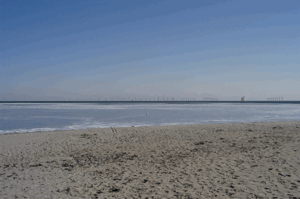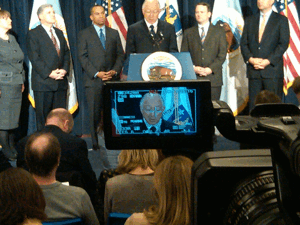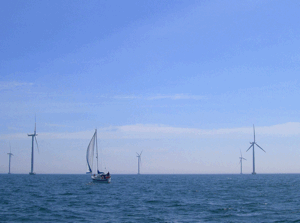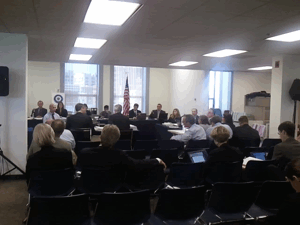The High Price for Free Wind Power
Air Date: Week of October 15, 2010

An artist’s rendition of what Nantucket sound will look like with offshore windmills. (Cape Wind)
After a ten-year battle through government bureaucracies, courts, and regulatory agencies, the nation's first offshore wind farm has just one more hurdle: money. Host Bruce Gellerman reports on how Massachusetts is trying to find a way to finance the Cape Wind project, even if it means relying on taxpayers.
Transcript
GELLERMAN: It’s Living on Earth, I’m Bruce Gellerman. Offshore wind is the fastest growing source of electricity in the world but the United States has been slow to harness the power of wind at sea. While Europe has 40 offshore wind farms operating today and 20 more in the works…the U.S. has precisely zero.
But that could rapidly change now that Google has announced it’s getting into offshore wind power--or I should say Google is getting under offshore wind power. The company has announced it’s teaming up with a New York financial firm to fund the construction of a huge underwater transmission line. The grid would connect still to be built wind farms at sea off the mid-Atlantic coast. Here’s Google’s Rick Needham.
NEEDHAM: This will serve as a superhighway with on ramps for wind farms and the ability to intelligently be expanded to increase the amount of offshore wind that’s available.
GELLERMAN: The U.S. is blessed with some of the best offshore wind in the world. By government estimates, the wind off the Atlantic Coast, Gulf of Mexico and Great Lakes could potentially generate four times the amount of electricity than that currently produced by all of our existing power plants combined.
GORDON: We are the Saudi Arabia of offshore wind.
GELLERMAN: And, Jim Gordon has big plans to make use of that embarrassment of renewable riches. Gordon is president of Cape Wind, a Massachusetts company planning to construct the nation’s first offshore wind farm. If and when it’s built, it will produce enough electricity to power to nearly a quarter of a million homes, with no climate change emissions.
GORDON: Cape wind is the largest single greenhouse gas mitigation initiative in the United States.
[SOUND OF WATER AND WIND]

An artist’s rendition of what Nantucket sound will look like with offshore windmills. (Cape Wind)
GELLERMAN: On Nantucket Sound just off the coast of Cape Cod, the wind blows strong and steady. It’s here on a 24 square mile site, on what’s called Horseshoe Shoal, that Jim Gordon wants to erect Cape Wind: 130 huge turbines mounted on giant towers driven deep into the shallow seafloor and close to transmission lines on land.
Cape Wind spokesman Mark Rodgers calls the site the perfect place to create energy out of thin air.
RODGERS: You know the basic concept is quite simple and I think that goes to kind of the elegance of it, which is that instead of burning coal or natural gas to create heat to boil water to make steam to exert a force to turn a turbine, right- which is how electricity is made the conventional way- or in the case of a nuclear reaction to create heat do the same thing, you know, here it is just the source of wind turning the wind turbine blades.

US Secretary of the Interior, Ken Salazar speaks to the press about Cape Wind (Photo: Jeff Young)
GELLERMAN: Offshore wind produces no air pollution, or radioactive waste. There’s no possibility of an oil disaster or the threat of foreign embargos. The wind is inexhaustible and the cost for the fuel- the wind- is zero. But…there’s a but…
HAUGHTON: It’s easy to get dazzled by the notion that wind has to be cheap… you know, the wind is free.
GELLERMAN: Jonathan Haughton is senior economist at Beacon Hill Institute. Over the years the free-market, think-tank has produced a series of reports that conclude Cape Wind will hurt tourism, and lower property values, now Haughton says the project is just too expensive.
HAUGHTON: The problem with offshore wind, wind power that’s built out at sea is just the enormously high cost of building the windmills in the first place. It’s the capital costs that’s the killer compared to onshore wind. If it had to operate on a market basis it simply wouldn’t start.
GELLERMAN: Ten years ago when it was first proposed Cape Wind was projected to cost 750 million dollars…today the construction costs have more than tripled. Cape Wind has been treading water for nearly a decade because never before had anyone tried to build a wind farm off the U.S. coast.
Jim Gordon essentially had to invent the process. It meant navigating 17 federal bureaucracies and state agencies…negotiating 140 laws and statues, producing a bookshelf of new environmental studies and surveys …and successfully fending off a dozen lawsuits.
GORDON: It shouldn’t take this long…because while we’ve gone thru this ten year tortuous process, the Europeans and now even the Chinese are blowing past us in terms of the off shore wind industry.
GELLERMAN: Still, despite the fact that Cape Wind has received all the federal and state permits and environmental permissions it needs, the project continues to be a hot political issue.
[APPLAUSE SOUNDS FROM GUBINATORIAL DEBATE]
GELLERMAN: At, the first gubernatorial debate in Massachusetts, Cape Wind was the issue.
PATRICK: It’s amazing that only in Massachusetts can we say that a project that has taken ten years to get from concept to final approval is hasty.
GELLERMAN: Democrat Governor Deval Patrick is running for reelection and the only candidate supporting Cape Wind.

An artist’s rendition of a sailboat among the proposed Cape Wind windmills. (Cape Wind)
PATRICK: I think it is good for us from an environmental point of view, from an energy point of view, from an economic point of view, and from a symbolic point of view.
GELLERMAN: Independent Candidate Tim Cahill disagrees.
CAHILL: Cape Wind is the wrong project, in the wrong place at the wrong time. We’re talking about windmills. Windmills is not a new technology. It’s not a technology that really, I think is moving us forward. It would be like me saying we should go back to steam engine rather than diesel for freight trains.
GELLERMAN: Republican candidate Charlie Baker says he supports renewable energy…just not Cape Wind.
BAKER: There are other alternatives that are available to us that are cheaper, more affordable, and in the end I believe better from a diversification strategy than this one. This is a monstrous big bet on one project when in many ways we probably should be better off letting a thousand flowers of other kinds bloom along the way.
GELLERMAN: Perhaps surprisingly, Jill Stein, the Green-Rainbow Party candidate, also questions the value of the offshore wind project.
STEIN: As Cape Wind comes to us it today it clearly is not delivering the most green energy for every dollar invested. And it’s asking for an enormous investment, probably two and a half billion dollars, that will mostly come from ratepayers.
GELLERMAN: A recent Boston Globe poll found nearly 70 percent of Massachusetts residents favor Cape Wind, but support drops to half when the price of its energy is considered. It’s only now, at the end of the process, that consumers have learned the price they’ll pay. Matt Da Prato, is an offshore wind analyst with Emerging Energy Research.
DA PRATO: Yeah it was one of those bridges that people didn’t really think about until they had to cross it and now we’re at that point and it’s at the forefront. And it’s a decision that ratepayers and policy makers will have to make on is this cost reasonable and are we willing to bear this burden.
GELLERMAN: “Reasonable” is the critically important word Massachusetts law uses to set renewable energy rates. But what’s reasonable to pay for energy from the nation’s first offshore wind farm? To find an answer, I headed to a hearing at the Massachusetts Department of Public Utilities.
My route turned out to be a small metaphor for the twists and turns the Cape Wind project has taken over the past decade.
[STREET NOISE]
GELERMAN: The DPU is located in Boston’s South Station. First, I got a badge from the receptionist…

At the end of the labyrinth leading to the Massachusetts Department of Public Utilities you’ll find lawyers and industry lobbyists determining if the price of Cape Wind’s energy is reasonable. (Bruce Gellerman)
[ELEVATOR DINGS]
GELLERMAN: And took an elevator to the second floor…
[ELEVATOR DINGS AGAIN]
GELLERMAN: There I showed my badge to another receptionist who gave me a key. I unlocked a door, held it open with my foot, and tossed the key back to the receptionist. Then at the end of a long hallway overlooking the train station, I walked down a short flight of steps…
[SOUND OF WALKING UP STEPS]
GELLERMAN: Then, took another elevator up to the fourth floor…
[ELEVATOR DINGS]
GELERMAN: And followed handwritten signs.
[SOUNDS OF THE HEARING ROOM]
GELLERMAN: The labyrinth led to a makeshift hearing room, which I found filled with lawyers and industry officials.
[WOMAN IN THE HEARING: In addition there are a number of information requests that have submitted pursuant to motions for protective treatment…A-G dash C-W dash three dash seven …A, B, and C….]
GELLERMAN: They were listening to a mind-numbing litany of renewal energy regulation minutia.
[WOMAN IN THE HEARING: A-P-N-S dash AG dash 1 dash…]
GELLERMAN: This slow moving hearing might lack the high drama of political debate, but it’s here that the future of Cape Wind, and indirectly, that of the nation’s offshore wind industry will be decided. Investors will be looking to see if offshore wind can be profitable.
For Cape Wind, it means convincing two of the three public utility commissioners that the cost of energy from the wind farm is “reasonable” and worth the price consumers will pay. But even Cape Wind’s Mark Rodgers acknowledges the price is high.
RODGERS: Well, offshore wind is more expensive than land based wind for example.
GELLERMAN: More than twice as expensive as wind generated on land or electricity produced by burning fossil fuels or nuclear power. Offshore wind requires special barges and costly equipment during construction and the towers and turbines have to be built to weather corrosive seawater and violent storms.
Initially Cape Wind wanted 21 cents a kilowatt-hour for its electricity. The Massachusetts Attorney General was able to knock two cents off that rate but permitted the price to rise three and a half percent a year for inflation. And utilities that purchase the electricity will get another four percent a year just for doing the deal. That’s too steep a price says Washington attorney Glenn Benson.
BENSON: Yeah, what they want to do is have Massachusetts’ ratepayers pay for the cost of developing Cape Wind when there are lower priced competitive alternatives available.
GELLERMAN: Benson represents Cape Wind’s nemesis, The Alliance to Protect Nantucket Sound. Fossil fuel billionaire Bill Koch is co-chair of the alliance and one of its largest financial backers. The Alliance’s new target is Massachusetts biggest utility, National Grid, because National Grid has agreed to buy half the energy Cape Wind will generate for 15 years.
BENSON: What we believe in is competition. And national grid should be buying from the lowest priced alternative, unless they show a really compelling reason to do otherwise and I don’t think they’ve come close to that here.
GELLERMAN: Actually, National Grid has a compelling reason: it’s required by law. Massachusetts, and 30 other states, have renewable energy portfolio standards. Each year utilities must purchase an increasing percentage of their energy from renewable sources. For Massachusetts it’s 20 percent renewable by 2020 and it goes up from there. And the state goes even further. Utilities must lock-in to long-term, clean energy contracts.
Ronald Gerwatowski, general counsel of National Grid, did a supply and demand analysis of the company’s future energy needs and found the utility had no alternative but to buy energy from Cape Wind.
GERWATOWSKI: And when we look across the next ten or 15 years, and we see this huge renewable resources gap and it’s our judgment that gap can’t be filled without Cape Wind being part of the mix.
GELLERMAN: Because utilities get their electricity from a variety of sources National Grid calculates the high price of Cape Wind energy will only cost the average consumer about a dollar and a quarter more a month. And Ian Bowles, Massachusetts Secretary of Energy and Environment, says the long-term contract will act as a hedge against fossil fuels price hikes in the future.
BOWLES: My view is that the contract is more likely than not to save money for consumers over its 15-year life. You know only thing we can say about energy price forecasting is that it’s almost always wrong and almost always too low.
GELLERMAN: Just two years ago, before the economic recession, energy demand and electricity prices were 30 percent higher. Back then the average Massachusetts ratepayer’s bill was 20 dollars more a month than today.
Supporters of offshore wind say its a long-term investment in the future that the added cost today is a small price to pay not just for clean, renewable electricity, but for launching a new industry that could add tens of thousands of jobs. The U.S. Department of Energy predicts by the year 2030 we’ll need a hundred Cape Wind sized projects, but the choice is ultimately ours says Matt Da Prato analyst with Emerging Energy Research.
DA PRATO: You know people aren’t going to put down their Ipods anytime soon. They’re not going to turn off their HDTV so it’s a matter of what price are you willing to keep that and that’s both an economic price and an environmental price. And the degree to which ratepayers and taxpayers think that we have to be more mindful of our environment will be the degree to which renewable energy succeeds or fails in the United States.
GELLERMAN: Massachusetts Department of Public Utilities will decide if the cost of Cape Wind’s energy is reasonable by mid November. But opponents still intent on killing the project have filed four new lawsuits and litigation could scare off potential investors. In the coming weeks, I’ll have a report about generating jobs and competition among states as they try to catch the wind.
Links
Living on Earth wants to hear from you!
Living on Earth
62 Calef Highway, Suite 212
Lee, NH 03861
Telephone: 617-287-4121
E-mail: comments@loe.org
Newsletter [Click here]
Donate to Living on Earth!
Living on Earth is an independent media program and relies entirely on contributions from listeners and institutions supporting public service. Please donate now to preserve an independent environmental voice.
NewsletterLiving on Earth offers a weekly delivery of the show's rundown to your mailbox. Sign up for our newsletter today!
 Sailors For The Sea: Be the change you want to sea.
Sailors For The Sea: Be the change you want to sea.
 Creating positive outcomes for future generations.
Creating positive outcomes for future generations.
 Innovating to make the world a better, more sustainable place to live. Listen to the race to 9 billion
Innovating to make the world a better, more sustainable place to live. Listen to the race to 9 billion
 The Grantham Foundation for the Protection of the Environment: Committed to protecting and improving the health of the global environment.
The Grantham Foundation for the Protection of the Environment: Committed to protecting and improving the health of the global environment.
 Contribute to Living on Earth and receive, as our gift to you, an archival print of one of Mark Seth Lender's extraordinary wildlife photographs. Follow the link to see Mark's current collection of photographs.
Contribute to Living on Earth and receive, as our gift to you, an archival print of one of Mark Seth Lender's extraordinary wildlife photographs. Follow the link to see Mark's current collection of photographs.
 Buy a signed copy of Mark Seth Lender's book Smeagull the Seagull & support Living on Earth
Buy a signed copy of Mark Seth Lender's book Smeagull the Seagull & support Living on Earth

